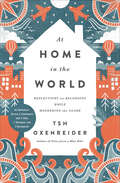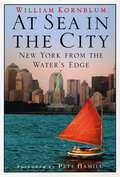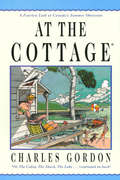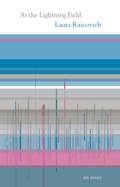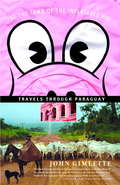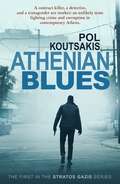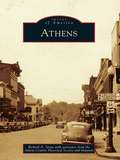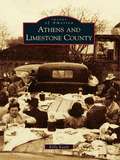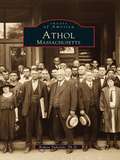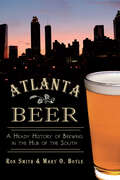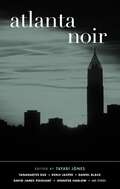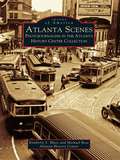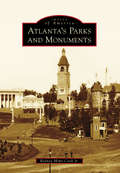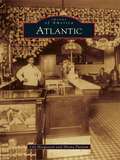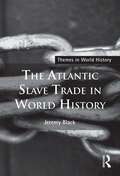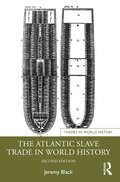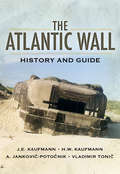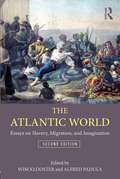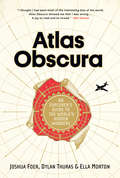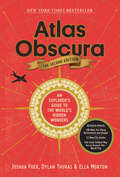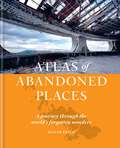- Table View
- List View
At Home in the World: Reflections on Belonging While Wandering the Globe
by Tsh OxenreiderAs Tsh Oxenreider, author of Notes From a Blue Bike, chronicles her family&’s adventure around the world—seeing, smelling, and tasting the widely varying cultures along the way—she discovers what it truly means to be at home.The wide world is calling.Americans Tsh and Kyle met and married in Kosovo. They lived as expats for most of a decade. They&’ve been back in the States—now with three kids under ten—for four years, and while home is nice, they are filled with wanderlust and long to answer the call.Why not? The kids are all old enough to carry their own backpacks but still young enough to be uprooted, so a trip—a nine-months-long trip—is planned.At Home in the World follows their journey from China to New Zealand, Ethiopia to England, and more. They traverse bumpy roads, stand in awe before a waterfall that feels like the edge of the earth, and chase each other through three-foot-wide passageways in Venice. And all the while Tsh grapples with the concept of home, as she learns what it means to be lost—yet at home—in the world.&“In this candid, funny, thought-provoking account, Tsh shows that it&’s possible to combine a love for adventure with a love for home.&” —Gretchen Rubin, New York Times bestselling author of The Happiness Project and Better Than Before
At Sea in the City: New York from the Water's Edge
by Pete Hamill William KornblumNew York is a city of few boundaries, a city of well-known streets and blocks that ramble on and on, into our literature, dreams, and nightmares. We know the city by the byways that split it, streets like Broadway and Madison and Flatbush and Delancey. From those streets, peering down the blocks and up at the top floors, the city seems immense and endless. And though the land itself may end at the water, the city does not. Long before Broadway was a muddy cart track, the water was the city's most distinguishing feature, the rivers the only byways of importance. Some people, like William Kornblum, still see the city as an urban archipelago, shaped by the water and the people who have sailed it for goods, money, pirate's loot, and freedom. For them, the City will always be an island. William Kornblum--New York City native, longtime sailor, urban sociologist, and first-time author--has spent decades plying the waterways of the city in his ancient catboat, Tradition. In At Sea in the City, he takes the reader along as he sails through his hometown, lovingly retelling the history of the city's waterfront and maritime culture and the stories of the men and women who made the water their own. In At Sea in the City and in Kornblum's own humility, humor, and sense of wonder, one detects echoes of E. B. White, John McPhee, and Joseph Mitchell.
At the Cottage
by Charles GordonWhatever you call it, every Canadian summer home needs at least one copy of Charles Gordon's wry, affectionate, and very funny study of our national obsession with that special summer place.From the Hardcover edition.
At the Lightning Field
by Laura RaicovichWalter De Maria's "Lightning Field" is 400 stainless steel poles, positioned 220 feet apart, in the desert of central New Mexico. Over the course of several visits, it becomes, for Raicovich, a site for confounding and revealing perceptions of time, space, duration, and light; how changeable they are, while staying the same.
At the Tomb of the Inflatable Pig
by John GimletteA wildly humorous account of the author's travels across Paraguay-South America's darkly fabled, little-known "island surrounded by land."Rarely visited by tourists and barely touched by global village sprawl, Paraguay remains a mystery to outsiders. Think of this small nation and your mind is likely to jump to Nazis, dictators, and soccer. Now, John Gimlette's eye-opening book-equal parts travelogue, history, and unorthodox travel guide-breaches the boundaries of this isolated land," and illuminates a little-understood place and its people.It is a wonderfully animated telling of Paraguay's story: of cannibals, Jesuits, and sixteenth-century Anabaptists; of Victorian Australian socialists and talented smugglers; of dictators and their mad mistresses; bloody wars and Utopian settlements; and of lives transplanted from Japan, Britain, Poland, Russia, Germany, Ireland, Korea, and the United States. The author travels from the insular cities and towns of the east, along ghostly trails through the countryside, to reach the Gran Chaco of the west: the "green hell" covering almost two-thirds of the country, where 4 percent of the population coexists-more or very-much-less peacefully-with a vast array of exotic wildlife that includes jaguars, prehistoric lungfish, and their more recently evolved distant cousins, the great fighting river fish. Gimlette visits with Mennonites and the indigenas, arms dealers and real-estate tycoons, shopkeepers, government bureaucrats and, of course, Nazis. Filled with bizarre incident, fascinating anecdote, and richly evocative detail, At the Tomb of the Inflatable Pig is a brilliant description of a country of eccentricity and contradiction, of beguilingly individualistic men and women, and of unexpected and extraordinary beauty. It is a vivid, often riotous, always fascinating, journey.From the Hardcover edition.
At the Tomb of the Inflatable Pig
by John GimletteA wildly humorous account of the author's travels across Paraguay-South America's darkly fabled, little-known "island surrounded by land." <P><P>Rarely visited by tourists and barely touched by global village sprawl, Paraguay remains a mystery to outsiders. Think of this small nation and your mind is likely to jump to Nazis, dictators, and soccer. Now, John Gimlette's eye-opening book-equal parts travelogue, history, and unorthodox travel guide-breaches the boundaries of this isolated land," and illuminates a little-understood place and its people. <P><P>It is a wonderfully animated telling of Paraguay's story: of cannibals, Jesuits, and sixteenth-century Anabaptists; of Victorian Australian socialists and talented smugglers; of dictators and their mad mistresses; bloody wars and Utopian settlements; and of lives transplanted from Japan, Britain, Poland, Russia, Germany, Ireland, Korea, and the United States. <P><P>The author travels from the insular cities and towns of the east, along ghostly trails through the countryside, to reach the Gran Chaco of the west: the "green hell" covering almost two-thirds of the country, where 4 percent of the population coexists-more or very-much-less peacefully-with a vast array of exotic wildlife that includes jaguars, prehistoric lungfish, and their more recently evolved distant cousins, the great fighting river fish. Gimlette visits with Mennonites and the indigenas, arms dealers and real-estate tycoons, shopkeepers, government bureaucrats and, of course, Nazis. <P><P>Filled with bizarre incident, fascinating anecdote, and richly evocative detail, At the Tomb of the Inflatable Pig is a brilliant description of a country of eccentricity and contradiction, of beguilingly individualistic men and women, and of unexpected and extraordinary beauty. It is a vivid, often riotous, always fascinating, journey.
Athenian Blues
by Pol KoutsakisStratos hates being called a hitman. He takes care of problems. Permanently. Problems that people pay handsomely to have solved. His clients don’t want to know the details, but Stratos is conscientious. He will only take on a job if his research shows that the targets deserve their fate.In the midst of the Greek economic crisis, Stratos takes on the highest-profile case of his career. The most celebrated lawyer in Greece and his beautiful actress wife both bid for his services, but which one is telling the truth? Helped by his three childhood friends, Drag, a homicide cop, Teri, a high-class transgender sex worker, and Maria, the love of his and Drag's life, he realises that truth is always relative.Especially when shattered loves and broken families are involved.
Athens
by James H.S. McGregorRevered as the birthplace of Western thought and democracy, Athens is much more than an open-air museum filled with crumbling monuments to ancient glory. Athens takes readers on a journey from the classical city-state to today's contemporary capital, revealing a world-famous metropolis that has been resurrected and redefined time and again. Although the Acropolis remains the city's anchor, Athens' vibrant culture extends far beyond the Greek city's antique boundaries. James H. S. McGregor points out how the cityscape preserves signs of the many actors who have crossed its historical stage. Alexander the Great incorporated Athens into his empire, as did the Romans. Byzantine Christians repurposed Greek temples, the Parthenon included, into churches. From the thirteenth to fifteenth centuries, the city's language changed from French to Spanish to Italian, as Crusaders and adventurers from different parts of Western Europe took turns sacking and administering the city. An Islamic Athens took root following the Ottoman conquest of 1456 and remained in place for nearly four hundred years, until Greek patriots finally won independence in a blood-drenched revolution. Since then, Athenians have endured many hardships, from Nazi occupation and military coups to famine and economic crisis. Yet, as McGregor shows, the history of Athens is closer to a heroic epic than a Greek tragedy. Richly supplemented with maps and illustrations, Athens paints a portrait of one of the world's great cities, designed for travelers as well as armchair students of urban history.
Athens: Excavations And Studies Conducted By The University Of Pennsylvania Museum And The British School At Athens (Images of America)
by Richard A. Straw Athens County Historical Society and MuseumIn the late 1700s, a group of men, largely from Massachusetts, came into the foothills of the Appalachian Mountains and settled a village in southeastern Ohio alongside the Hocking River. Calling it Athens to honor their belief in the primacy of education and culture in one's life, they set in motion a history that continues to inform and enliven life within this community today. Ohio University, the first public institution of higher learning in the Northwest Territory, was founded here in 1804. Athens has served as a business, service, cultural, and educational meeting place for over 200 years. As a result, Athens is a culturally diverse community of professors, plumbers, lawyers, craftsmen, restaurateurs, students, musicians, artists, and business owners, and it is heir to a historic past. This collection of fascinating photographs of people, places, homes, businesses, churches, and important events comes from the vast archives of the Athens County Historical Society and Museum. The images open the past and provide an informative glimpse into an earlier period of life in this unique community.
Athens and Limestone County
by Kelly KazekAthens and Limestone County were founded in 1818, the year before Alabama became a state, making Athens one of its oldest cities. The quaint, picturesque downtown square in Athens, the county seat, is the heart of the community. Athens and Limestone County are studies in the ongoing tug-of-war between tradition and progress. Athens is traditionally a railroad and cotton town--once ranking among the state's largest cotton producers--but since the aerospace boom of the 1960s, it has increasingly entered the orbit of the technology center of nearby Huntsville, home of the U.S. Space and Rocket Center and Redstone Arsenal. These days, Athens is home to many manufacturing firms, and local civic groups are focused on revitalizing downtown and bringing tourists to Limestone County.
Athol, Massachusettes
by Robert TuholskiNestled among the hills of Massachusetts, 70 mileswest of Boston, Athol lies on the banks of the Millers River. First settled as "Pequoiag" in 1735 and incorporated as Athol in 1762, the evolution of Athol from a sparse, agrarian settlement to a bustling industrial community is a blueprint for the transformation of small-town America. This exciting collection presents a visual history of Athol at the dawn of the twentieth century. Athol, Massachusettsdocuments the changes as the town developed from an agrarian community into a thriving manufacturing center that harnessed Mill Brook and the Millers River to power the early mills. Through photographs, stereo cards, and postcards from a bygone era, this book provides a glimpse of what it was like to live and work in the Athol of long ago. The photographs from years gone by allow both young and old to meander down dirt roads along the stream, and become witness to their celebrations and their recreational retreats at the fairgrounds, Silver Lake, and Brookside Park.
Atlanta Beer: A Heady History of Brewing in the Hub of the South (American Palate Ser.)
by Ron Smith Mary O. Boyle&“Delve[s] into a colorful past . . . Stories of early taverns and saloons, religious zeal, prohibition and the roots of the current craft beer boom.&” —Atlanta Journal Constitution Atlanta is a unique southern city known for its vast diversity and fast-paced lifestyle. Rarely is it associated with a rich beer and brewing culture, but not for a lack of one. From Atlanta&’s first brewery in the 1850s to the city&’s Saloon Row and the parched days of local and national Prohibition, the earliest days of Atlanta&’s beer history are laced with scandal and excitement. Follow the journey of beer through Atlanta&’s development, starting with colonial Georgia and the budding wilderness settlement of Terminus and eventually evolving into the ever-growing metropolis known as Atlanta. Authors Ron Smith and Mary Boyle celebrate the resurgence of craft beer in a town that once burned to the ground. As Atlanta rose from the ashes of the Civil War, so also has artisanal beer made a comeback in this enigmatic but resilient city. &“The brewery sections draw attention to some long-neglected businesses . . . But the chapter on Prohibition may be the most fascinating part of the book.&” —American Breweriana Journal &“A fascinating read for any craft beer lover in the Southeast. The book features chapters on frontier taverns of the area, Atlanta&’s first beer boom, stories of early breweries of the city, the brewpub trend and the rise of current breweries located in Georgia&’s capital.&” —Owen Ogletree&’s Brewtopia Brewsletter
Atlanta Noir (Akashic Noir #0)
by Daniel Black Tananarive Due Jim Grimsley Anthony Grooms Jennifer Harlow John Holman Dallas Hudgens Kenji Jasper Sheri Joseph Brandon Massey Alesia Parker David James Poissant Gillian RoyesGeorgia Center for the Book has chosen Atlanta Noir as one of 2018's Books All Georgians Should Read!Kenji Jasper's "A Moment of Clarity at the Waffle House" nominated for a 2018 Edgar Award for Best Short Story!"Atlanta has its share, maybe more than its share, of prosperity. But wealth is no safeguard against peril...Creepy as well as dark, grim in outlook...Hints of the supernatural may make these tales...appealing to lovers of ghost stories."--Kirkus Reviews"These stories, most of them by relative unknowns, offer plenty of human interest...All the tales have a Southern feel."--Publishers Weekly"Jones, author of Leaving Atlanta, returns to the South via Akashic's ever-growing city anthology series. The collection features stories from an impressive roster of talent including Jim Grimsley, Sheri Joseph, Gillian Royes, Anthony Grooms and David James Poissant. The 14 selections each take place in different Atlanta neighborhood."--Atlanta-Journal Constitution"Now comes Atlanta Noir, an anthology that masterfully blends a chorus of voices, both familiar and new, from every corner of Atlanta...The magic of Atlanta Noir is readily apparent, starting with the introduction Jones pens. It doesn’t rest solely upon the breadth of writers but on how their words, stories and references are so Atlanta--so very particular, so very familiar and so very readily, for those who know the city, nostalgic. And for those who don’t? The sense of place it captures inspires a desire to get to know Atlanta and its stories."--ArtsATLAkashic Books continues its award-winning series of original noir anthologies, launched in 2004 with Brooklyn Noir. Each book comprises all new stories, each one set in a distinct neighborhood or location within the respective city. This much-anticipated and long-overdue installment in Akashic's Noir Series reveals many sides of Atlanta known only to its residents.Brand-new stories by: Tananarive Due, Kenji Jasper, Tayari Jones, Dallas Hudgens, Jim Grimsley, Brandon Massey, Jennifer Harlow, Sheri Joseph, Alesia Parker, Gillian Royes, Anthony Grooms, John Holman, Daniel Black, and David James Poissant.From the introduction by Tayari Jones:Atlanta itself is a crime scene. After all, Georgia was founded as a de facto penal colony and in 1864, Sherman burned the city to the ground. We might argue about whether the arson was the crime or the response to the crime, but this is indisputable: Atlanta is a city sewn from the ashes and everything that grows here is at once fertilized and corrupted by the past...These stories do not necessarily conform to the traditional expectations of noir...However, they all share the quality of exposing the rot underneath the scent of magnolia and pine. Noir, in my opinion, is more a question of tone than content. The moral universe of the story is as significant as the physical space. Noir is a realm where the good guys seldom win; perhaps they hardly exist at all. Few bad deeds go unrewarded, and good intentions are not the road to hell, but are hell itself...Welcome to Atlanta Noir. Come sit on the veranda, or the terrace of a high-rise condo. Pour yourself a glass of sweet tea, and fortify it with a slug of bourbon. Put your feet up. Enjoy these stories, and watch your back.
Atlanta Scenes: Photojournalism in the Atlanta History Center Collection
by Atlanta History Center Michael Rose Kimberly S. BlassAtlanta, the thriving capital of the New South, has a rich and fascinating history. In Atlanta Scenes, authors Kimberly S. Blass and Michael Rose draw from the works of some of the city's earliest and finest photojournalists--Francis Price, Marion Johnson, Bill Wilson, and Kenneth Rogers--to bring that history to life. Atlanta Scenes documents some of the city's noteworthy events, personalities, and landmarks, many of which will be readily identifiable. The images range from the everyday (baseball games at Ponce de Leon Ballpark, boys on bicycles, and Humane Society dog rescues) to the eventful (the Gone with the Wind premiere, the deadly Winecoff Hotel fire, and the infamous Leo Frank trial). Many scenes reflect the iconography of the Old South, while others provide insight into the harsh realities of twentieth-century life. In this volume, well-crafted, artistic images blend with on-the-spot action shots.
Atlanta's Parks and Monuments
by Rodney Mims Cook Jr.Since the city's beginnings after the War of 1812, Atlanta has had a tradition of building with a regard for becoming a world-class metropolis. Before being burned by Union general William T. Sherman in 1864, the city's appearance was described by noted European architect and urban planner Leon Krier as "looking like London in the 18th century." Atlanta was surrounded by estates and plantations, and many of the plantation builders were influenced by Greek and Roman architecture. The argument of slavery to the contrary, builders saw Greek temples as symbols of democracy and, as a result, embraced Greek and Roman revival architecture as the dominant national style. Great monuments followed in this tradition to the letter in the capital of the South.
Atlantic
by Shiona Putnam Lila HoogeveenThe history of Atlantic is rooted in the story of unrelenting entrepreneur Franklin H. Whitney. His passion inspired a strong and enterprising breed of men who embraced his vision and settled in the lush hills and valleys of Cass County, Iowa, in the decade following the close of the Civil War. The railroad provided the impetus for rapid growth and prosperity, and Whitney's vision of a new city became a reality when his recommendation for a depot site was approved. Within six days, Whitney's agent, Thomas Miller, had built the first house from which Whitney ordered furrows plowed to the railroad grading. Atlantic was thus born. The town grew rapidly, and by 1869 civic and social organizations, churches, newspapers, banks, schools, and businesses were thriving. Atlantic also had its share of shady characters, outlaw gangs, and disasters. The photographs and stories in this book provide a glimpse into the lives of Atlantic's intrepid developers and the city they established in the valley of the Nishnabotna.
Atlantic High: A Celebration
by William F. Buckley Jr.William F. Buckley Jr.'s account of his voyage across the Atlantic Ocean in the sailboat Sealestial, Atlantic High is a work that everywhere evidences Buckley's love for sailing and good companionship. Infused with his inimitable wit and supported by a rich fund of anecdotes and observations, Atlantic High is truly a one-of-a-kind work.
The Atlantic Slave Trade in World History (Themes in World History)
by Jeremy BlackIn The Atlantic Slave Trade in World History, Jeremy Black presents a compact yet comprehensive survey of slavery and its impact on the world, primarily centered on the Atlantic trade. Opening with a clear discussion of the problems of defining slavery, the book goes on to investigate the Atlantic slave trade from its origins to abolition, including comparisons to other systems of slavery outside the Atlantic region and the persistence of modern-day slavery. Crucially, the book does not ask readers to abandon their emotional ties to the subject, but puts events in context so that it becomes clear how such an institution not only arose, but flourished. Black shows that slavery and the slave trade were not merely add-ons to the development of Western civilization, but intimately linked to it. In a vital and accessible narrative, The Atlantic Slave Trade in World History enables students to understand this terrible element of human history and how it shaped the modern world.
The Atlantic Slave Trade in World History (Themes in World History)
by Jeremy BlackNow in its second edition, The Atlantic Slave Trade in World History has been updated to include recent scholarship, and an analysis of how debates have changed in light of recent key events such as the Black Lives Matter movement.Primarily focused on the Atlantic Slave Trade, this study places slavery within a broader world context and includes significant detailed coverage of Africa. With a chronological approach, it guides students through the origins of the Atlantic Slave Trade to its expansion and eventual abolition. Its final chapters explore the legacy of the Atlantic Slave Trade by comparing it to other systems of slavery outside of the Atlantic region, and analyze the persistence of modern-day slavery. As well as offering an analysis of historiography, the updated bibliography and conclusion, which considers the recent Black Lives Matter protests and their aftermath, provide a fresh account of how slavery has shaped our understanding of the modern world.Unmatched in its breadth of information, chronological sweep, and geographical coverage, The Atlantic Slave Trade in World History is the most useful introductory resource for all students who study the Atlantic Slave Trade in a world context.
The Atlantic Wall: History and Guide
by J. E. Kaufmann H. W. Kaufmann A. Jankovic-Potocnik Vladimir TonicThis WWII history and visitor&’s guide explores the extensive network of Nazi fortifications built to defend Fortress Europe. Hitler's Atlantic Wall, the complex system of coastal fortifications that stretched from Norway to the Spanish border during the Second World War, was built to defend occupied Europe from Allied invasion. Many of its principal structures survive and can be visited today. This authoritative guide provides both practical information for visitors and essential historical context. The wall, which was constructed on a massive scale between 1942 and 1944 by German engineers, forced laborers and troops, consisted of strong points, artillery casemates, bunkers, troop shelters, minefields, anti-tank and anti-boat obstacles. It also included the concrete U-boat and E-boat pens in the key ports and, behind the Channel coast, the V-weapon sites. This huge scheme of fortifications was one of the longest series of defensive lines in military history. This comprehensive volume takes readers and visitors through the entire story of the fortifications from the fall of France to the D-Day invasion on the beaches of Normandy that finally broke through. As a guide to some of the most impressive relics of the Second World War, this book is essential reading for travelers or anyone interested in the liberation of occupied Europe.
The Atlantic World: Essays on Slavery, Migration, and Imagination
by Willem Klooster Alfred PadulaThe Atlantic World: Essays on Slavery, Migration, and Imagination brings together ten original essays that explore the many connections between the Old and New Worlds in the early modern period. Divided into five sets of paired essays, it examines the role of specific port cities in Atlantic history, aspects of European migration, the African dimension, and the ways in which the Atlantic world has been imagined. This second edition has been updated and expanded to contain two new chapters on revolutions and abolition, which discuss the ways in which two of the main pillars of the Atlantic world—empire and slavery—met their end. Both essays underscore the importance of the Caribbean in the profound transformation of the Atlantic world in the late eighteenth and early nineteenth centuries. This edition also includes a revised introduction that incorporates recent literature, providing students with references to the key historiographical debates, and pointers of where the field is moving to inspire their own research. Supported further by a range of maps and illustrations, The Atlantic World: Essays on Slavery, Migration, and Imagination is the ideal book for students of Atlantic History.
Atlas Obscura: An Explorer's Guide to the World's Hidden Wonders (Atlas Obscura)
by Joshua Foer Dylan Thuras Ella MortonIt's time to get off the beaten path. Inspiring equal parts wonder and wanderlust, Atlas Obscura celebrates over 700 of the strangest and most curious places in the world. Talk about a bucket list: here are natural wonders—the dazzling glowworm caves in New Zealand, or a baobob tree in South Africa that's so large it has a pub inside where 15 people can drink comfortably. Architectural marvels, including the M.C. Escher-like stepwells in India. Mind-boggling events, like the Baby Jumping Festival in Spain, where men dressed as devils literally vault over rows of squirming infants. Not to mention the Great Stalacpipe Organ in Virginia, Turkmenistan's 40-year hole of fire called the Gates of Hell, a graveyard for decommissioned ships on the coast of Bangladesh, eccentric bone museums in Italy, or a weather-forecasting invention that was powered by leeches, still on display in Devon, England. Created by Joshua Foer, Dylan Thuras and Ella Morton, ATLAS OBSCURA revels in the weird, the unexpected, the overlooked, the hidden and the mysterious. Every page expands our sense of how strange and marvelous the world really is. And with its compelling descriptions, hundreds of photographs, surprising charts, maps for every region of the world, it is a book to enter anywhere, and will be as appealing to the armchair traveler as the die-hard adventurer. Anyone can be a tourist. ATLAS OBSCURA is for the explorer.
Atlas Obscura, 2nd Edition: An Explorer's Guide to the World's Hidden Wonders (Atlas Obscura)
by Joshua Foer Ella Morton Dylan Thuras Atlas ObscuraThe bestselling book that celebrates wonder all around the world and in our backyards, now in an updated second edition with more than 120 brand-new destinations to explore, new city guides, and a full-color gatefold map.
The Atlas of Abandoned Places
by Oliver SmithThe globe is littered with forgotten monuments, their beauty matched only by the secrets of their past.A glorious palace lies abandoned by a fallen dictator. A grand monument to communism sits forgotten atop a mountain. Two never-launched space shuttles slowly crumble, left to rot in the middle of the desert. Explore these and many more of the world's lost wonders in this atlas like no other.With remarkable stories, bespoke maps and stunning photography of fifty forsaken sites, The Atlas of Abandoned Places travels the world beneath the surface; the sites with stories to tell, the ones you won't find in any guidebook.Award-winning travel writer Oliver Smith is your guide on a long-lost path, shining a light on the places that the world forgot.Locations featured in the book include:Europe: Maunsell Forts, Aldwych Station, Paris Catacombs, La Petite Ceinture, Craco, Teufelsberg, Beelitz-Heilstätten, Red Star Train Graveyard, Pyramiden, Salpa Line, Buzludzha Monument, Pripyat, Wolf's Lair, Project Riese, Sarajevo Bobsleigh Track, Albanian Bunkers, Rummu QuarryThe Americas & the Carribean: New Bedford Orpheum Theatre, City Hall Station, Bodie, The Boneyards of Western USA, Bannerman Castle, Palace of Sans Souci, Montserrat Exclusion Zone, Ciudad Perdida, Humberstone and Santa Laura, Uyuni Train Cemetery, FordlândiaThe Middle East & the Caucasus: Kayaköy, Burj Al Babas, Varosha, Tskaltubo, Palaces of SaddamAsia: Ryugyong Hotel, Buran at Baikonur, Mo'ynoq Ship Graveyard, Aniva Lighthouse, Hô' Thuy Tiên Waterpark, Fukushima Red Zone, HashimaOceania: Wittenoom, Wrecks of Homebush Bay, Port Arthur, MS World Discoverer, Second World Remains of Papua New GuineaAfrica: Shipwrecks of the Skeleton Coast, Kolmanskop, Mobutu's Gbadolite, Mos Espa, São Martinho dos Tigres
The Atlas of Abandoned Places
by Oliver SmithThe globe is littered with forgotten monuments, their beauty matched only by the secrets of their past.A glorious palace lies abandoned by a fallen dictator. A grand monument to communism sits forgotten atop a mountain. Two never-launched space shuttles slowly crumble, left to rot in the middle of the desert. Explore these and many more of the world's lost wonders in this atlas like no other.With remarkable stories, bespoke maps and stunning photography of fifty forsaken sites, The Atlas of Abandoned Places travels the world beneath the surface; the sites with stories to tell, the ones you won't find in any guidebook.Award-winning travel writer Oliver Smith is your guide on a long-lost path, shining a light on the places that the world forgot.Locations featured in the book include:Europe: Maunsell Forts, Aldwych Station, Paris Catacombs, La Petite Ceinture, Craco, Teufelsberg, Beelitz-Heilstätten, Red Star Train Graveyard, Pyramiden, Salpa Line, Buzludzha Monument, Pripyat, Wolf's Lair, Project Riese, Sarajevo Bobsleigh Track, Albanian Bunkers, Rummu QuarryThe Americas & the Carribean: New Bedford Orpheum Theatre, City Hall Station, Bodie, The Boneyards of Western USA, Bannerman Castle, Palace of Sans Souci, Montserrat Exclusion Zone, Ciudad Perdida, Humberstone and Santa Laura, Uyuni Train Cemetery, FordlândiaThe Middle East & the Caucasus: Kayaköy, Burj Al Babas, Varosha, Tskaltubo, Palaces of SaddamAsia: Ryugyong Hotel, Buran at Baikonur, Mo'ynoq Ship Graveyard, Aniva Lighthouse, Hô' Thuy Tiên Waterpark, Fukushima Red Zone, HashimaOceania: Wittenoom, Wrecks of Homebush Bay, Port Arthur, MS World Discoverer, Second World Remains of Papua New GuineaAfrica: Shipwrecks of the Skeleton Coast, Kolmanskop, Mobutu's Gbadolite, Mos Espa, São Martinho dos Tigres
